Blue & Purple Pea Flowers
The family Fabaceae is one of our larger plant families, containing the peas, beans, vetches, clovers and other, closely-related groups. The family is readily distinguished by its unique flower shape, well-known to anyone who has grown peas or beans as vegetables or enjoyed the fragrant flowers of Sweet Peas. There are many woody members of the family, too, such as Wisteria, Black Locust, Laburnum, Gorse and Broom. The flowers have five petals, but they are of unequal size and shape and form what is known as a zygomorphic flower. This is a flower that is symmetrical through just one plane (and therefore appears to have a 'right way up'), rather than an actinomorphic flower which is symmetrical through many planes - such as daisies, buttercups and many other flowers. The uppermost petal of a pea flower is usually the largest and often referred to as the 'standard'. The flower then has two, smaller petals either side of the standard, which are known as the 'wings'. Below the wings are two petals that are fused together to form a boat-shaped structure whch is known as the 'keel'. The keel is often hidden beneath the wings and may not always be obvious without investigation.
The structure of pea flowers varies little - although some tend to be broad-petalled, very showy flowers that are carried singly or in elongate spikes while others are small, narrow and almost tubular in appearance. In the latter case, the flowers are often carried in larger quantity and clustered into a head (e.g. clovers). Because the flower structure varies little, identification from this page on is based mainly on leaf detail (pinnate, trifoliate etc.) and growth type (creeping, woody-stemmed, etc.). As this is such a large group, this page will help narrow your search, once you have arrived here from the flower colour pages.
The main purpose of this page is to attempt to break this family up into bite-sized chunks, so that the pages you are led to do not get too big by containing a large number of species. At worst, if you follow a link from here and do not see your plant, return to this page and try another link. Note that some species may come in a variety of flower colours; in such cases, the species is shown on more than one page, so you should still find it.
At this stage, be sure to read the texts below carefully, as they contain identification information that may not be visible in the photographs; clicking to the next stage will help you get to the exact species.
Use the photos below to narrow your search to a group, then click on the picture to go to the next stage.
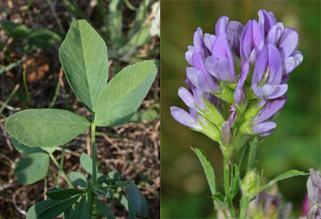 |
Lucernes
Usually low growing, spreading plants or small annuals, but some of these species may reach a metre in height amongst taller vegetation. Showy flowers appear in small clusters, usually all emerging from a single point on the stem; various shades of purple, bluish-purple or pale blue - or even almost black. Leaves composed of three leaflets. |
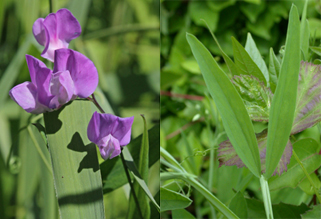 |
Everlasting Peas
This is a very distinctive group of plants and particularly eye-catching due to the large and showy flowers. Plants typically have flattened, winged stems (although sometimes unwinged), which grow rapidly and trail on the ground or scramble over neighbouring vegetation. The leaves are pinnate, but may be reduced to just a single pair of leaflets, the rest of the leaf then consisting of a twining tendril. Each leaflet is much longer than wide and may resemble grass blades in appearance. |
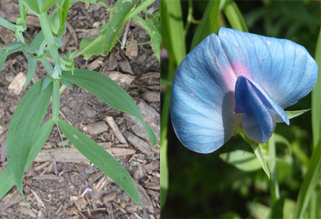 |
Everlasting Peas
This is a very distinctive group of plants and particularly eye-catching due to the large and showy flowers. Plants typically have flattened, winged stems (although sometimes unwinged), which grow rapidly and trail on the ground or scramble over neighbouring vegetation. The leaves are pinnate, but may be reduced to just a single pair of leaflets, the rest of the leaf then consisting of a twining tendril. Each leaflet is much longer than wide and may resemble grass blades in appearance. |
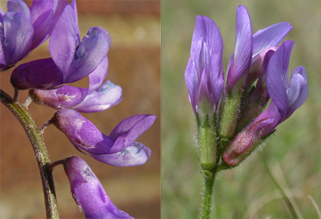 |
Purple or Blue Vetches & Allies
A variable bunch of plants, but all have leaves that are pinnate, with a series of broad or narrow side leaflets, arranged in pairs like a small ladder. Leaves may have a small leaflet at the tip, or there may be a tendril in its place. The flowers are very variable in appearance and in colour (from almost white, washed with light purple, to deep purple-blue) usually showy and may be in a large, clustered, often upright spike, or may be solitary in the leaf axils. |
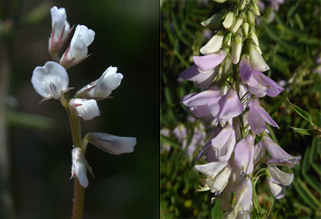 |
Purple or Blue Vetches & Allies
A variable bunch of plants, but all have leaves that are pinnate, with a series of broad or narrow side leaflets, arranged in pairs like a small ladder. Leaves may have a small leaflet at the tip, or there may be a tendril in its place. The flowers are very variable in appearance and in colour (from almost white, washed with light purple, to deep purple-blue) usually showy and may be in a large, clustered, often upright spike, or may be solitary in the leaf axils. |
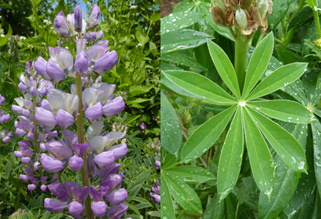 |
Lupins
The lupins are rather distinct among members of the pea family with elongate, many-flowered, upright spikes of flowers. But the best way to tell them from other members of the pea family is by the palmate leaves, which typically have seven or more leaflets, all radiating out from the leaf stalk. Lupins may be small, annual species; taller, clump-forming perennials or woody-stemmed shrubs and may have single-coloured or bicoloured flowers in almost any shade of yellow, blue, pink, purple, red or white. |